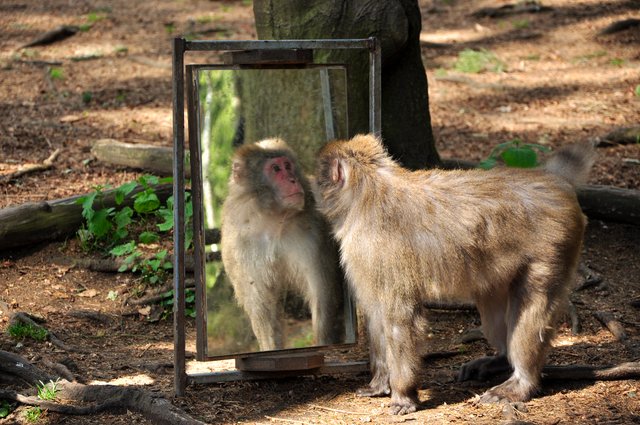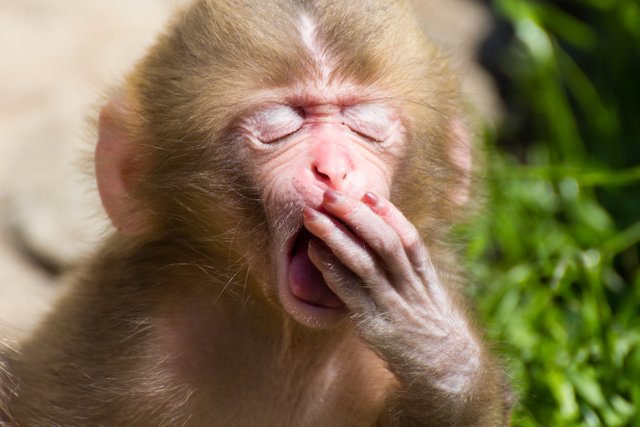Psychology of morality – mirror, mirror on the wall
The last part gave you some insights about the evolutionary foundations of moral behaviour. Now, we are getting to know something about the probably most fascinating (or most hyped) theory in neurosciences. Follow me, the rabbit hole awaits you again.
This is the second part of a series. I recommend starting with the first one.
The inner mirror
All hope seemed to be lost. You didn’t know the woman begging for the survival of her child. Quite the opposite, you just learned, that rescuing a child you are not related in the slightest, would not be beneficial to your reproductive fitness in any way. The risk of losing your own life as well, was too high. Your “selfish genes”, as Richard Dawkins (1) called them, valued their own survival way higher in this case. Thus, you slowly started to walk away.
But something was odd. Some kind of invisible force seemed to drag you back, forcing you to reconsider your decision.
Just before the woman was able to call you out for being egoistical (obviously, she understood the concept of evolution quite well), you turn around.
Smart readers could argue, this is because of social reciprocity, because helping the woman would increase your own social attractiveness. This can be one explanation, but there is more to it.
The reason for you change of mind has a lot to do with empathy, especially with something called “mirror neurons” (2).

Source
Mirror’s edge
No, this has nothing to do with the 2008 released game by EA DICE, but I was quite fond of the title.
Mirror neurons were among the most amazing discoveries on the way of understanding human behaviour. In 1991, the scientist Giuseppe Di Pellegrino, Luciano Fadiga, Leonardo Fogassi and Vittorio Gallese sent a paper (3) to Nature about an interesting discovery of a special set of neurons, they had found in the ventral premotor cortex of a monkey. The fascinating aspect about these neurons was, that were firing when the monkey performed a specific action (grabbing an object), as well as when it was witness to another individual (could be human or another monkey) performing the same or a similar act – thus the name “mirror neurons”.
Nature rejected the paper, not knowing, they waved away one of the most important scientific discoveries of recent history.
But why is the mirroring of actions so important for human behaviour? Because it enables us to actually empathize and feel, what the other individual is experiencing. Thus, provides us with increased abilities of compassion and shared joy. This is important to know, because with mirror neurons the possibility of cooperation and helping others increases significantly – and be it, just to avoid your own suffering or raising one’s own happiness. Therefore, mirroring behaviour of other individuals provides us with an edge towards our own fitness and survival capabilities, a mirror’s edge. Badum Tss.
I’m so funny, I know.
A look into the mirror
But let’s dig a little bit deeper into the details.
You are now aware of the general idea of mirror neurons, so it’s about time, to increase your understanding of this concept. This is going to be quite technical (though I am trying to simplify it a bit), so if you are fine with the general part, just skip this one.
According to the current research, the human mirror neuron system is most probably located in the areas of the ventral premotor cortex, inferior frontal cortex and inferior parietal lobe.
But a study by Gazzola et al. (2008) (4) suggested, there might be other areas with mirror neurons as well, so more research is needed. A short overview about the state of research in 2013 was provided by Kilner et al. (5).
Important note:
Wikipedia states that the “superior parietal lobe” is one of the areas in humans where mirror neurons can be found. But this was not consistent with the studies I have read. Although there are some, which reported activation of mirror neurons in the superior parietal lobe (e.g. Hamzei et al., 2003 (6); Grafton et al., 1996 (7); Culham et al., 2003(8)), it appears the majority of studies was only able to confirm the involvement of the inferior parietal lobe. If anyone has additional information, I would be glad to read it.

Source
Scientifically spoken, mirror neurons are the evidence for vicarious activations: the neural substrates of one’s own actions are vicariously activated, when one is experiencing the actions of other individuals through visual or auditive stimuli (Keysers & Gazzola, 2014) (9).
It is quite likely, that the vast amount of differences in mirrored neural responses are partly learned.
Thus, the research regarding mirror neurons is strongly connected to something called “Hebbian learning” (10) based on spike-timing-dependent plasticity (STDP) (11). Donald Hebb (12) was a Canadian psychologist, who proposed a neurophysiological principle associated with learning and memory:
‘When an axon of cell A is near enough to excite a cell B and repeatedly or persistently takes part in firing it, some growth process or metabolic change takes place in one or both cells such that A’s efficiency, as one of the cells firing B, is increased.
To understand this clearly, it is important to be aware of the concepts of causality and consistency.
Some of you might know the rhyme “what fires together, wires together.” This is somewhat misleading. Hebb did not write, that two neurons need to fire together to increase the efficiency of their connection. He stated, that neuron A needs to repeatedly (consistency) take part in firing (causality) neuron B. That is an important difference to make. The presynaptic neuron needs to fire repeatedly just before the postsynaptic one, to have a potentiating effect on the synapse in the end.
As for STDP, you can imagine it as a neurological process, which is responsible for adjusting the strength of neuron connections. This is based on the relative timing of a neuron’s output and input potentials (spikes).
How does this affect mirror neurons?
It seems convincing, that mirror neurons are generated through a complex process of repeated re-afference (the auditive and visual experience of one’s own performed action) and therefore the use of Hebbian learning seems to apply. Thus, matching synaptic connections are created and the likelihood of the occurrence of mirrored experiences increases. With these information in mind, it is not unlikely, that experience and creation of mirror neurons regarding emotions and sensations follow a similar principle (Keysers & Gazzola, 2014). Furthermore, you should know, that mirror neurons are divided into the ones which are “strictly congruent” and those which are “broadly congruent” (Gallese et al. 1996) (13). The mirror neurons, in which effective observed as well as effective executed actions correspond, regarding their goal (e.g. grasping) and means for it (e.g., precision grip), are categorized as “strictly congruent”. The neurons, which do not require the exact same action being observed to trigger, are therefore regarded as “broadly congruent”. This is an important distinction to make, because it enables you to be empathic, even if the witnessed action is somewhat different from your own experiences. You don’t need to get shot, to empathize with a shooting victim, because you are already able to refer to their experience of pain.
But beware: the mirroring is not happening in a 1:1 ratio. It is still a huge difference, whether you see another person gets beaten up by a bunch of hooligans – or if you are the unlucky guy. It is only an approach towards their feelings in the end, but that is at least something.
Iacoboni (2009) (14) pointed out, that the available research on mirror neurons, imitation and empathy convincingly suggests, that being empathic towards other individuals is indeed a valid evolutionary strategy. Most people believe, our biology determines us to behave in a self-serving, individualistic way, but our ideas of ethical behaviour and a code of conduct enable us to throw away the chains of our neurobiological makeup. It appears, that science tells us otherwise so far.

Source
Smashing the mirror?
Alright, this was a short glimpse into one of the most fascinating theory in modern neuroscience. I hope, I was able to provide you with a better understanding of this idea and why it is so important to know more about it.
We are now a step closer towards the development or moral ideas. You can now explain the evolutionary and neurological foundations of our ability, to behave in a moral way.
But as @sco correctly pointed out in his comment on the last part, it seems to be a bit simplistic, to only speak about evolution and neurological patterns and avoid mentioning social context at all. This is something, of which I am quite aware of. Therefore, we will leave the area evolution and neuroscience a little bit behind us (but not too far, don’t worry) and turn towards the many challenges which are connected to the aspect of our socialization.
Our daily lives are proof enough, that although our evolutionary foundations may have provided us with some amazing tools of expressing empathy towards our fellow human beings, it is hardly always the case. If you are curious about the reasons and whether some people are really just assholes, you will probably find some satisfaction in reading the next part.
Stay tuned.
Feel always free to discuss my ideas and share your own thoughts about the things I’m writing about. Nobody is omniscient and if we all walk away a bit smarter than before, we’ll have achieved a lot. Thanks for reading.
Ego

Make sure, to check out #steemstem for more science related content.
References
(1) Dawkins, Richard. In Defence of Selfish Genes. Volume 56. Issue 218. October 1981. 556-573. https://doi.org/10.1017/S0031819100050580
(2) https://en.wikipedia.org/wiki/Mirror_neuron
(3) Rizzolatti, G. & Fabbri-Destro, M. Exp Brain Res (2010) 200: 223. https://doi.org/10.1007/s00221-009-2002-3
(4) Gazzola, Valeria; Keysers, Christian. The Observation and Execution of Actions Share Motor and Somatosensory Voxels in all Tested Subjects: Single-Subject Analyses of Unsmoothed fMRI Data. Cerebral Cortex. Volume 19. Issue 6. 1 June 2009. 1239–1255. https://doi.org/10.1093/cercor/bhn181
(5) Kilner, J.M.; Lemon, R.N. What We Know Currently about Mirror Neurons. Curr Biol. 2013. 23(23). R1057–R1062. doi: 10.1016/j.cub.2013.10.051
(6) Hamzei F, Rijntjes M, Dettmers C, Glauche V, Weiller C, Buchel C. The human action recognition system and its relationship to Broca’s area: an fMRI study. NeuroImage. 2003;19:637–644. https://doi.org/10.1016/S1053-8119(03)00087-9
(7) Grafton ST, Fagg AH, Woods RP, Arbib MA. Functional anatomy of pointing and grasping in humans. Cerebral Cortex. 1996b;6(2):226–237
(8) Culham JC, Danckert SL, DeSouza JFX, Gati JS, Menon RS, Goodale MA. Visually guided grasping produces fMRI activation in dorsal but not ventral stream areas. Experimental Brain Research. 2003;153:180–189. https://doi.org/10.1007/s00221-003-1591-5
(9) Keysers C, Gazzola V. 2014. Hebbian learning and predictive mirror neurons for actions, sensations and emotions. Phil. Trans. R. Soc. B 369: 20130175. http://dx.doi.org/10.1098/rstb.2013.0175
(10) https://en.wikipedia.org/wiki/Hebbian_theory
(11) https://en.wikipedia.org/wiki/Spike-timing-dependent_plasticity
(12) https://en.wikipedia.org/wiki/Donald_O._Hebb
(13) Gallese V, Fadiga L, Fogassi L, Rizzolatti G. 1996. Action recognition in the premotor cortex. Brain 119(Pt. 2):593–609
(14) Iacoboni, Marco. Imitation, Empathy, and Mirror Neurons. Annual Review of Psychology. Vol. 60:653-670. 10 January 2009. https://doi.org/10.1146/annurev.psych.60.110707.163604
Deutsche Version
Psychologie der Moral – Spieglein, Spieglein an der Wand
Der letzte Teil hat euch einige Einsichten über die evolutionären Grundlagen moralischen Verhaltens beschert. Jetzt werden wir etwas über die wahrscheinlich faszinierendste (oder gehypteste) Theorie der Neurowissenschaften erfahren. Folgt mir, der Kaninchenbau erwartet euch erneut.
Das ist der zweite Teil einer Serie. Ich empfehle, mit dem ersten zu beginnen.
Der innere Spiegel
Alle Hoffnung schien verloren. Ihr kanntet die Frau nicht, die um das Überleben ihres Kindes bettelte. Eher im Gegenteil, gerade erst hattet ihr gelernt, dass die Rettung eines Kindes, zu dem man nicht die geringste Beziehung hatte, der eigenen reproduktiven Fitness nicht im Geringsten nutzen würde. Das Risiko, das eigene Leben ebenso zu verlieren, war zu hoch. Eure „egoistischen Gene“, wie Richard Dawkins (1) sie nannte, werteten ihr eigenes Überleben in diesem Fall um Einiges höher. Ihr begannt daher, langsam fortzugehen.
Aber etwas war seltsam. Eine Art unsichtbare Macht schien euch zurückzuziehen, zwang euch, eure Entscheidung zu überdenken.
Kurz bevor es der Frau möglich war, euch als egoistisch zu bezeichnen (offensichtlich verstand sie das Konzept der Evolution ziemlich gut), drehtet ihr euch um.
Aufmerksame Leser könnten jetzt argumentieren, das wäre aufgrund der sozialen Reziprozität, da es unsere eigene soziale Attraktivität erhöhen würde, wenn wir der Frau helfen. Das kann eine Erklärung sein, doch dahinter steckt mehr.
Der Grund für euren Sinneswandel hat eine Menge mit Empathie zu tun, um genau zu sein, mit sogenannten „Spiegelneuronen“ (2).

Quelle
Mirror’s edge
Nein, das hat nichts mit dem 2008 erschienen Spiel von EA DICE zu tun, aber ich fand den Titel ganz amüsant.
Spiegelneuronen gehören zu den spannendsten Entdeckungen auf dem Weg des Verständnisses von menschlichem Verhalten. Im Jahr 1991 sendeten die Wissenschaftler Giuseppe Di Pellegrino, Luciano Fadiga, Leonardo Fogassi und Vittorio Gallese ein Paper (3) an Nature, in welchem sie über die interessante Entdeckung eines speziellen Sets von Neuronen, das sie im ventralen prämotorischen Kortex eines Affen gefunden hatten. Der faszinierende Aspekt dieser Neuronen war, dass sie sowohl feuerten, wenn der Affe eine bestimmte Aktion ausführte (ein Objekt griff), als auch wenn er ein anderes Individuum (entweder ein Mensch oder ein anderer Affe) dabei beobachtete, dieselbe oder eine ähnliche Aktion auszuführen – daher der Name „Spiegelneuronen“.
Nature wies das Paper ab, ohne sich dessen bewusst zu sein, dass sie eine wichtigsten wissenschaftlichen Entdeckungen der jüngsten Geschicke abgewunken hatten.
Doch warum ist die Spiegelung von Handlungen so wichtig für das menschliche Verhalten? Weil es uns ermöglicht, wirklich empathisch zu sein und zu fühlen, was dem anderen Individuum widerfährt. Aus diesem Grund vermittelt sie uns mit verbesserten Fähigkeiten des Mitleids und der geteilten Freude. Das ist wichtig zu wissen, denn mit der Existenz von Spiegelneuronen, steigt die Wahrscheinlichkeit zur Kooperation und anderen zu helfen, signifikant an – und sei es, um eigenes Leiden zu vermeiden oder das eigene Glücksempfinden zu steigern. Daher verschafft das Spiegeln (mirror) des Verhaltens anderer uns einen Vorteil (edge) bezüglich unserer eigenen Fitness und Überlebensfähigkeiten, quasi ein „Mirror’s edge“. Badum Tss.
Ich bin so witzig, ich weiß.
(Auf Englisch funktioniert das irgendwie besser.)
Ein Blick in den Spiegel
Aber lasst uns etwas tiefer in die Details eintauchen.
Ihr habt jetzt eine Vorstellung der generellen Idee von Spiegelneuronen, es ist also an der Zeit, euer Verständnis dieses Konzepts zu vertiefen. Das wird relativ technisch werden (auch wenn ich versuche, es etwas zu vereinfachen), wenn ihr also mit generellen Teil zufrieden seid, überspringt diesen hier einfach.
Aktueller Forschung zufolge, ist das menschliche Spiegelneuronen-System wahrscheinlich in den Arealen des ventralen prämotorischen Kortex, des inferioren frontalen Kortex und dem inferioren parietalen Lappen verortet. Allerdings legte eine Studie von Gazzola et al. (2008) (4) nahe, dass wahrscheinlich noch andere Areale mit Spiegelneuronen existieren, weshalb mehr Forschung vonnöten ist. Eine kurze Übersicht des Forschungsstands von 2013 haben Kilner et al. (5) bereitgestellt.
Wichtiger Hinweis:
Wikipedia spricht davon, dass der „superiore parietale Lappen“ eines der Areale ist, in denen Spiegelneuronen gefunden werden können. Das war allerdings nicht konsistent mit den Studien, die ich gelesen habe. Obwohl es einige gibt, die eine Aktivierung von Spiegelneuronen im superioren parietalen Lappen vermeldet haben ((z.B. Hamzei et al., 2003 (6); Grafton et al., 1996 (7); Culham et al., 2003(8)), sieht es danach aus, dass die Mehrheit der Studien nur eine Beteiligung des inferioren parietalen Lappens bestätigen konnte. Falls jemand zusätzliche Informationen hat, würde ich diese gerne lesen.

Quelle
Wissenschaftlich gesprochen, sind Spiegelneuronen der Beweis für stellvertretende Aktivierungen: Die neuralen Substrate der eigenen Handlungen werden stellvertretend aktiviert, wenn man die Handlungen von anderen Individuen durch visuelle oder auditive Stimuli wahrnimmt (Keysers & Gazzola, 2014) (9).
Es ist sehr wahrscheinlich, dass die große Anzahl an Unterschieden in gespiegelten neuralen Reaktionen teilweise erlernt sind.
Aus diesem Grund ist die Forschung bezüglich Spiegelneuronen stark mit der sogenannten Hebbschen Lernregel (10) und spike-timing-dependent plasticity (STDP) (11) verbunden.
Donald Hebb (12) war ein kanadischer Psychologe, der ein neurophysiologisches Prinzip vorgeschlagen hat, das mit Lern- und Gedächtnisprozessen assoziiert ist:
„Wenn ein Axon der Zelle A […] Zelle B erregt und wiederholt und dauerhaft zur Erzeugung von Aktionspotentialen in Zelle B beiträgt, so resultiert dies in Wachstumsprozessen oder metabolischen Veränderungen in einer oder in beiden Zellen, die bewirken, dass die Effizienz von Zelle A in Bezug auf die Erzeugung eines Aktionspotentials in B größer wird.“
Um das genau zu verstehen, ist es wichtig, sich der Konzepte von Kausalität und Konsistenz bewusst zu sein.
Einige von euch kennen vielleicht den Reim „what fires together, wires together“ – und auch die deutsche Wikipedia verweist (leider) darauf. Das ist allerdings etwas irreführend. Hebb schrieb nicht davon, dass zwei Neuronen zusammen feuern müssen, um die Effizienz ihrer Verbindung zu erhöhen. Er sagte, dass Neuron A wiederholt (Konsistenz) beim Feuern auf Neuron B (Kausalität) beteiligt sein muss. Das ist ein wichtiger Unterschied. Das präsynaptische Neuron muss wiederholt vor dem postynaptischen feuern, um einen potenzierenden Effekt auf die Synapse am Ende zu haben.
STDP kann man sich als demzufolge als einen neurologischen Prozess vorstellen, welcher dafür verantwortlich ist, die Stärke der neuronalen Verbindungen auszurichten. Das basiert auf dem relativen Timing des Outputs- und Inputs-Potentials (spikes) eines Neurons.
Wie beeinflusst das Spiegelneuronen?
Es scheint überzeugend, dass Spiegelneuronen durch einen komplexen Prozess von wiederholter Re-Afferenz (die auditive und visuelle Erfahrung eigener ausgeführter Handlungen) generiert werden und daher scheint die Hebbsche Lernregel angewandt zu sein. Dadurch werden passende synaptische Verbinden erschaffen und die Wahrscheinlichkeit des Auftretens von gespiegelten Erfahrungen steigt. Mit diesen Informationen im Hinterkopf, ist es nicht unwahrscheinlich, dass Erfahrung und Erschaffung von Spiegelneuronen bezüglich Emotionen und Gefühlen einem ähnlichen Prinzip folgen (Keysers & Gazzola, 2014).
Des Weiteren solltet ihr wissen, dass Spiegelneuronen in diejenigen unterteilt werden, die „strikt kongruent“ und jene, die „weitgehend kongruent“ (Gallese et al. 1996) (13) sind. Die Spiegelneuronen, in welchen sowohl effektiv beobachtete als auch effektiv ausgeführte Aktionen korrespondieren, bezüglich ihres Ziels (z.B. greifen) und Zwecks (z.B. präziser Griff), werden als „strikt kongruent“ kategorisiert. Die Neuronen, die nicht die exakt gleiche beobachtete Handlung als Auslöser benötigen, werden demzufolge als „weitgehend kongruent“ bezeichnet. Das ist eine wichtige Unterscheidung, da sie euch ermöglicht, empathisch zu sein, selbst wenn die beobachtete Handlung etwas von euren eigenen Erfahrungen abweicht. Ihr braucht nicht angeschossen zu werden, um mit einem Schussopfer mitfühlen zu können, da ihr bereits fähig seid, einen Bezug zu ihrem Schmerzempfinden herzustellen.
Aber aufgepasst: Die Spiegelung findet nicht in einem 1:1-Verhältnis statt. Es ist immer noch ein großer Unterschied, ob ihr eine andere Person seht, die von einer Gruppe Hooligans zusammengeschlagen wird – oder ob ihr der Unglückliche seid. Am Ende ist es nur eine Annäherung an deren Empfindungen, aber das ist immerhin etwas.
Iacoboni (2009) (14) hat darauf hingewiesen, dass die verfügbare Forschung zu Spiegelneuronen, Imitation und Empathie überzeugend vermuten lässt, dass empathisch zu anderen Individuen zu sein, tatsächlich eine valide evolutionäre Strategie darstellt. Viele Menschen glauben, unsere Biologie determiniert uns dazu, sich in einer eigennützigen, individualistischen Weise zu verhalten; aber unsere Ideen von Ethik und Verhaltensregeln ermöglichen es uns, die Ketten unseres neurobiologischen Überbaus abzuwerfen. Es scheint, dass die Wissenschaft dazu eine andere Meinung hat.

Quelle
Den Spiegel zerschlagen?
Nun denn, das war ein kurzer Ausblick in eine der faszinierendsten Theorien moderner Neurowissenschaften. Ich hoffe, es war mir möglich, euch mit einem besseren Verständnis dieser Idee zu versorgen und warum es so wichtig ist, mehr darüber zu wissen.
Wir sind nun einen Schritt näher in Richtung der Entwicklung moralischer Ideen. Ihr könnt jetzt die evolutionären und neurologischen Grundsteine unseres moralischen Verhaltens erklären.
Aber wie @sco richtigerweise in seinem Kommentar zum vorherigen Part herausgestellt hat, erscheint es etwas simplizistisch zu sein, nur über Evolution und neurologische Muster zu sprechen, während man sozialen Kontext komplett vermeidet. Das ist etwas, dessen ich mir sehr bewusst bin. Deshalb werden wir das Feld der Evolution und Neurowissenschaften ein wenig hinter uns lassen (nicht allzu weit, keine Sorge) und uns den vielen Herausforderungen zuwenden, die mit dem Aspekt unserer Sozialisation verbunden sind.
Unser Alltag ist Beweis genug, dass, obwohl unsere evolutionären Grundbausteine uns vielleicht mit einigen spannenden Werkzeugen versorgt haben, um Empathie gegenüber unseren Mitmenschen auszudrücken, ist das schwerlich immer der Fall. Wenn ihr neugierig über die Gründe seid und ob einige Menschen tatsächlich einfach nur Arschlöcher sind, werdet ihr wahrscheinlich mit dem Lesen des nächsten Teils zufriedengestellt.
Bleibt gespannt.
Fühlt euch jederzeit frei, meine Ideen zu diskutieren und eure Gedanken über die Dinge, die ich thematisiere, zu teilen. Niemand ist allwissend und wenn wir alle ein bisschen klüger als zuvor daraus hervorgehen, werden wir eine Menge erreicht haben. Danke fürs Lesen.
Ego

Falls ihr euch für Wissenschaft begeistern könnt, dann schaut unbedingt unter #steemstem bzw. #de-stem vorbei!
Quellen
(1) Dawkins, Richard. In Defence of Selfish Genes. Volume 56. Issue 218. October 1981. 556-573. https://doi.org/10.1017/S0031819100050580
(2) https://en.wikipedia.org/wiki/Mirror_neuron
(3) Rizzolatti, G. & Fabbri-Destro, M. Exp Brain Res (2010) 200: 223. https://doi.org/10.1007/s00221-009-2002-3
(4) Gazzola, Valeria; Keysers, Christian. The Observation and Execution of Actions Share Motor and Somatosensory Voxels in all Tested Subjects: Single-Subject Analyses of Unsmoothed fMRI Data. Cerebral Cortex. Volume 19. Issue 6. 1 June 2009. 1239–1255. https://doi.org/10.1093/cercor/bhn181
(5) Kilner, J.M.; Lemon, R.N. What We Know Currently about Mirror Neurons. Curr Biol. 2013. 23(23). R1057–R1062. doi: 10.1016/j.cub.2013.10.051
(6) Hamzei F, Rijntjes M, Dettmers C, Glauche V, Weiller C, Buchel C. The human action recognition system and its relationship to Broca’s area: an fMRI study. NeuroImage. 2003;19:637–644. https://doi.org/10.1016/S1053-8119(03)00087-9
(7) Grafton ST, Fagg AH, Woods RP, Arbib MA. Functional anatomy of pointing and grasping in humans. Cerebral Cortex. 1996b;6(2):226–237
(8) Culham JC, Danckert SL, DeSouza JFX, Gati JS, Menon RS, Goodale MA. Visually guided grasping produces fMRI activation in dorsal but not ventral stream areas. Experimental Brain Research. 2003;153:180–189. https://doi.org/10.1007/s00221-003-1591-5
(9) Keysers C, Gazzola V. 2014. Hebbian learning and predictive mirror neurons for actions, sensations and emotions. Phil. Trans. R. Soc. B 369: 20130175. http://dx.doi.org/10.1098/rstb.2013.0175
(10) https://de.wikipedia.org/wiki/Hebbsche_Lernregel
(11) https://en.wikipedia.org/wiki/Spike-timing-dependent_plasticity
(12) https://de.wikipedia.org/wiki/Donald_O._Hebb
(13) Gallese V, Fadiga L, Fogassi L, Rizzolatti G. 1996. Action recognition in the premotor cortex. Brain 119(Pt. 2):593–609
(14) Iacoboni, Marco. Imitation, Empathy, and Mirror Neurons. Annual Review of Psychology. Vol. 60:653-670. 10 January 2009. https://doi.org/10.1146/annurev.psych.60.110707.163604
This is a test comment, notify @kryzsec on discord if there are any errors please.
Being A SteemStem Member
Very very interesting post. :) Thanks for the nice research and crossover between neuroscience, psychology, as well as for stating so many cool sources. I gonna have to check them out.
Best,
mountain.phil28
Thanks a lot :)
For me it's always important to provide a valid, fact-based view of a certain topic, that's why I usually have a decent amount of references for further details. Glad, you like it :)
Extremely interesting, this concept of mirror neurons, and extremely well described! Ty.
I'll give you a resteem from @de-stem as soon as I am at a PC with access to the account again.
Looking forward to part 3!
Thanks a lot :)
I was really hoping to deliver a way of presenting this concept, which is not too technical in the end. Although I'm somehow still waiting for a neuroscientist to come along and starting to complain about not mentioning important fact XY :D
Hey ego,
mir viel zu trocken, aber sehr gut!! ;D
Ich würde über Spiegelneuronen definitv eine andere Geschichte schreiben. Lach...
Ich werde mir den 3.Teil auf jeden Fall anschaun! Ich bin schon gespannt und freu mich! :D
LG Mo*
Danke :)
Ich hatte ja gewarnt, dass es in diesem Teil sehr technisch wird, aber ich habe es schon so weit reduziert, wie ich es für vertretbar halten konnte :)
Der dritte Teil wird vermutlich (hoffentlich) sprachlich eleganter :)
es war perfekt ausgearbeitet!! :)
wie gesagt, ich warte ;D
Whould you like to join your sp with my account @minnowunited created for this purpose. I am thinking of 30 people group contribute equal sp. Any question in mind feel free to ask. We can use this account for the betterment of primary account. Just reply this comment. Or you can ask me on this discord server https://discord.gg/QCZuR7N